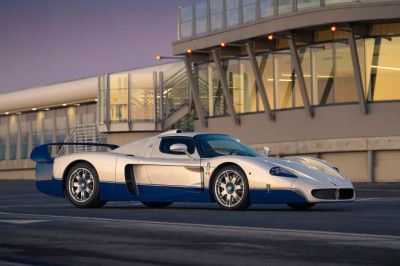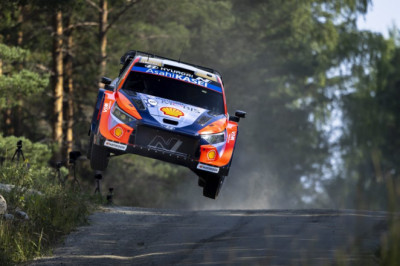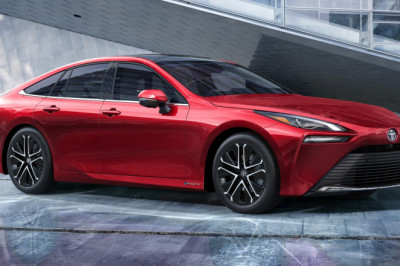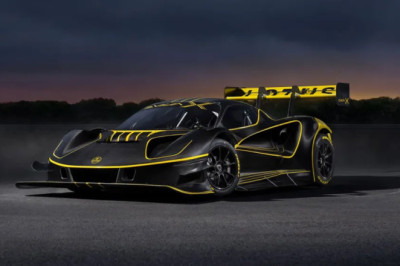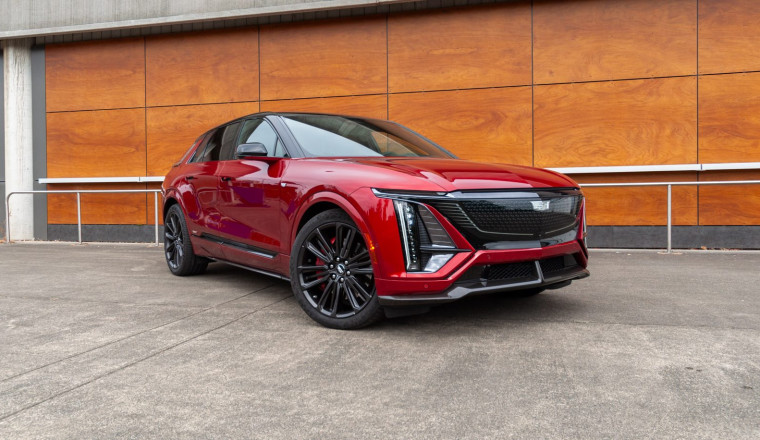
By Joel Feder
My head physically hurt from the pressure as the Cadillac Lyriq-V ripped off the line for a 0-60 mph sprint. Then the party trick, of which I performed for an hour until Team Cadillac said “time’s up,” quickly became normalized and the pain went away.
Also, I was quicker than Cadillac advertises its latest V to be. The pain went away, but it was real at first. Despite being so quick it can be painful the interior coddles occupants in leather, soft touch everything, metal-feeling chrome bits, and an overall sense of luxury most people probably figured Cadillac forgot how to put into production. Even better, it’s all hidden inside a gorgeous wrapper that isn’t overwrought with a bunch of tacked-on carbon fiber doodads. This is all the antithesis of a modern AMG and so American, it’s hard not to be proud that Cadillac seems to be back.
The 2026 Cadillac Lyriq-V is the first electric vehicle to wear a V-Series badge, it’s the quickest production Cadillac in history, and is an understated package with few shortcomings, none of which are even V-specific.
Far from a new car, the Cadillac Lyriq-V is a quicker, more powerful, more expensive performance variant of the Lyriq we’ve all come to know, and really like, over the last few years. It also brings forth a few enhancements to the rest of the Lyriq lineup for 2026. It now sits atop of the Lyriq lineup and might just be the stealth executive luxury EV to buy.
This thing is a sleeper, and I’m here for it in a way that AMG seems to have either forgotten or abandoned in its quest for a younger audience. A quick glance at the Lyriq won’t reveal this is the V model. It’ll take a deeper look, or a Cadillac enthusiast (is this a thing?) to quickly note this isn’t a standard Lyriq. The gorgeous dash-to-axle ratio and short rear end all paired with wicked LED lighting carries over. The V models get specific front and rear lower fascias, revised 22-inch wheels, sill and rear tailgate badging, a standard black roof (which can be optioned on other Lyriqs), 0.62-inch lower ride height (surely you noticed). For buyers desiring more flair there’s the optional carbon fiber front and rear splitter/diffuser paired with side sill extensions for $5,700. It’ll be hard to know this thing is a V while moving down the road at speed.
Inside it’s standard Lyriq fare, which is great. That translates to a 33-inch LED display augmented by buttons, knobs, and my personal favorite, toggles. It’s a clean design with comfortable, supportive seats. The same packaging compromises present in every Lyriq, and most Ultium-based EVs, still exist including a hilariously deep dashboard and rear seats that sit a smidge too high. But I would happily road trip in this thing. There’s no ridiculous carbon fiber bits, and the team didn’t go nuts with the touchscreen’s software. There’s some red background bits on the screen and a new V mode button on the steering wheel and in the drive mode selector page. That’s it, and that’s just fine.
The real changes for the V come underneath the sheet metal. The same 102-kWh battery pack that’s in every other Lyriq feeds upgraded motors on each axle (one per) and upgraded inverters for a total output of 615 hp and 650 lb-ft of torque in Velocity Max mode. The battery pack itself isn’t changed from other Lyriqs, but because the V was coming every Lyriq’s battery cooling system was upgraded with new plumbing of the valves to increase flow in the name of literal chill. The battery’s discharge current limit has been increased 25% (via software), which is why the enhanced cooling was needed. Each drive mode has been programmed to call up the cooling system to prep and ensure optimized temps by splitting the system’s output between the battery and climate control. The drive units themselves feature new final drive ratios with the front unit moving from 9.85 to 11.59 and the rear going from 10.5 to 11.6. Cadillac also increased the rear drive unit’s half shaft diameter from 41mm to 44mm.
Unlike the 2026 Rivian R1T Quad, Cadillac upgraded the Lyriq-V’s brakes to handle the increased power with 6-piston Brembo calipers grabbing 15.3-inch front discs and carry-over single-piston 13.6-inch rotors in the rear.
For better control (and less roll) the V model gets Sachs adaptive dampers, making it the only Lyriq to not ride on passive dampers. Cadillac engineer Alex Doss told The Drive the team went with adaptive dampers instead of magnetic ride control because EVs are heavy and the adaptive dampers with continuous damping control with a valve-based system have a larger spread for rebound control, which is really needed on a vehicle of this weight—5,980 pounds, to be exact. The rest of the suspension has been upgraded to deal with the increased forces that comes with more power. This ranges from the rear roll bar being 533% stiffer (that’s not a typo) to the front top mount being 140% stiffer and the #3 cradle mount being 677% stiffer.
Cadillac’s engineers also gave the Lyriq-V a quicker steering ratio moving from 18.44:1 to 15.81:1. It’s a minor speed increase that’s not noticed from behind the wheel, but also feels natural.
Velocity Max and Competition Modes have come along for the ride, with the former uncorking the powertrain and the latter loosening the reins on stability control and turning off traction control. Launch Control is also part of the package to enable the 3.3-second 0-60 mph sprint, according to Cadillac. Spoiler: It’s quicker than that.
View this post on InstagramA post shared by The Drive (@thedrive)
Cadillac let me loose in a closed-off parking lot to rip 0-60 mph runs for an hour straight. Cadillac said the Lyriq-V does the deed in 3.3 seconds, but I did it in 3.2 immediately with Launch Control according to the onboard time, which also measures 0-100 mph and a 1/4 mile time. Enabling Launch control is easy. Simply tap the V button on the steering wheel, push the brake pedal to the floor, push the accelerator to the floor, let off the brake, hold onto that steering wheel because things now move quickly. Another journalist somehow hit 3.0 seconds flat for the 0-60 mph sprint. Naturally I slid behind the wheel and continued to launch off the line until I matched his number. Had time not run out I would’ve kept going until the car forced me to stop or I hit 2.9 seconds.
But after an hour the brakes, which never seemed to change in feel or pedal travel, started to smoke when I got out of the car. The Lyriq-V tested was running the standard summer square setup of Continental Premier Contact 275/40R22 tires paired with the available $100 performance low-metallic brake pads.
Cadillac said the Lyriq-V’s top speed clocks in at 130 mph, but I didn’t test the claim.
Around an autocross course Cadillac setup for us in a large parking lot I was able to easily swing the rear end out with Competition Mode enabled, and even overcooked it too much in one turn resulting in smokey donuts. I’ll admit, I didn’t let off the throttle, rather I buried it. Team Cadillac’s facial expressions were worth it. Sorry, not sorry.
On public roads with long, fast sweepers I preferred the steering in Tour mode rather than Sport, as extra heft for the sake of being heavy is weird. The suspension difference between Sport and Tour is minor, but it’s a little stiffer with broken pavement making its way through into the seat bottom a bit more in the former. But it’s the throttle mapping between Tour and Sport that’s most noticeable. Sport mode for the throttle uncorks initial tip-in and the power comes on much quicker than in Tour mode. While Sport mode is fun on backroad sweepers, it’s simply too much around town, especially going from stoplight to stoplight.
Every Lyriq but the base model now features two exterior speakers beyond the federally-mandated pedestrian warning system. These speakers, one in the front and one in the rear, can play synthetic noise to give the Lyriq… emotion? The V gets its own sound naturally dubbed V. None of the sounds mimic a gas engine, rather it falls somewhere between a luxurious hum in Tour mode to a space-like thruster in Sport and V modes. From Tour, Sport, and V each mode gets progressively louder. There’s also Stealth, which just shuts down the speakers and lets the Lyriq be silent. Our pre-production car’s software wasn’t what customers will experience and it’s hard to comment or judge what I heard, but it was futuristic. We’ll see what the production software sounds like. Part of me felt it sounded futuristic, while part of me just kept thinking, “this is stupid, it’s electric, why is it making noises.” Your opinion will vary, and apparently so too will what the production Lyriq-V sounds like.
The Lyriq-V is the first electric Cadillac to wear a V badge, but the word Blackwing is nowhere to be found. Alex Doss, lead development engineer for the Lyriq-V, told The Drive the Blackwing is a totally different echelon and type of performance with a track focus. The Lyriq-V seems to preview Cadillac’s future while doing what it can with today’s packaging, technology, and budget constraints. The Escalade is the range topper, and prints money for Cadillac, but nothing the automaker sells today is this quick, and certainly nothing combines this kind of speed and smoothness in terms of power delivery.
Mercedes has already realized it failed at its first attempt with luxury EVs in America and has hit pause on the EQs. Meanwhile, Cadillac Global Vice President John Roth told The Drive during a business update earlier in the month that the automaker intends to be the luxury EV leader by 2030. So far, Cadillac seems to be on the path to be just that. Despite disappearing incentives Cadillac still sees EVs as critical.
Cadillac estimates the Lyriq-V will have an EPA-rated range of 285 miles, which is a hit of anywhere from 41 to 34 miles compared to other Lyriqs. In 50.8 miles of mixed suburban, city, and highway driving the Lyriq-V managed 2.4 mi/kWh, which would translate to 245 miles of range. You can probably tell that I didn’t baby it.
When the 2026 Cadillac Lyriq-V arrives in the coming weeks it will cost $80,090 including a $1,495 destination charge. The “base” V is the one I’d recommend as it’s well equipped with everything from a 23-speaker AKG sound system and augmented reality heads-up display to GM’s class-leading Level 2 hands-free driver-assist system known as Super Cruise. Spending up another $5,200 for the V Premium adds Nappa leather and a panoramic sunroof (instead of a fixed glass roof) and a 19.2-kw onboard charging system. We don’t yet know the exact price spread of the V over other Lyriq’s as 2026 pricing isn’t released for the standard lineup yet, but a 2025 Lyriq costs $58,595 in base form, and a top-tier Sport 3 AWD model costs $76,905. A fair guesstimate of a few grand premium is about where the V seems to check in at, and for that money it seems worth it for the extra power and standard features if leveling up to more premium Lyriqs. That said, if the extra power isn’t desired the standard Lyriq is a darn nice vehicle that still does 0-60 mph in 4.6 seconds in dual-motor AWD form.
The Lyriq-V checks up to $5,895 more than Audi SQ6 E-Tron, but it’s also significantly quicker and better looking inside and out. It’s also $30,660 less expensive, and better looking, than the Mercedes-Benz AMG EQE SUV, which has been shelved due to poor sales.
With extremely limited seat time, of which I need more at a later date, the Lyriq-V feels like the complete sleeper package pairing luxury and a gorgeous design with speed in a way AMG’s failed to do so far. The team in Affalterbach should be taking notes on this one because this is a heck of a daily driver, regardless of what’s powering it.
Cadillac’s created a sleeper performance SUV that doubles as a gorgeous daily driver.
As Director of Content and Product, Joel draws on over 15 years of newsroom experience and inability to actually stop working to help ensure The Drive shapes the future of automotive media.
Car Buying Service
By Caleb Jacobs






